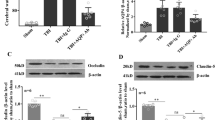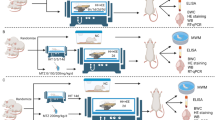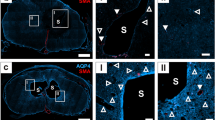Abstract
Background
Cerebral edema after cardiac arrest (CA) is associated with increased mortality and unfavorable outcome in children and adults. Aquaporin-4 mediates cerebral water movement and its absence in models of ischemia improves outcome. We investigated early and selective pharmacologic inhibition of aquaporin-4 in a clinically relevant asphyxial CA model in immature rats in a threshold CA insult that produces primarily cytotoxic edema in the absence of blood-brain barrier permeability.
Methods
Postnatal day 16–18 Sprague-Dawley rats were studied in our established 9-min asphyxial CA model. Rats were randomized to aquaporin-4 inhibitor (AER-271) vs vehicle treatment, initiated at return of spontaneous circulation. Cerebral edema (% brain water) was the primary outcome with secondary assessments of the Neurologic Deficit Score (NDS), hippocampal neuronal death, and neuroinflammation.
Results
Treatment with AER-271 ameliorated early cerebral edema measured at 3 h after CA vs vehicle treated rats. This treatment also attenuated early NDS. In contrast to rats treated with vehicle after CA, rats treated with AER-271 did not develop significant neuronal death or neuroinflammation as compared to sham.
Conclusion
Early post-resuscitation aquaporin-4 inhibition blocks the development of early cerebral edema, reduces early neurologic deficit, and blunts neuronal death and neuroinflammation post-CA.
Similar content being viewed by others
Log in or create a free account to read this content
Gain free access to this article, as well as selected content from this journal and more on nature.com
or
References
Hanning, U. et al. Automated assessment of early hypoxic brain edema in non-enhanced CT predicts outcome in patients after cardiac arrest. Resuscitation 104, 91–94 (2016).
Langkjaer, S. et al. Prognostic value of reduced discrimination and oedema on cerebral computed tomography in a daily clinical cohort of out-of-hospital cardiac arrest patients. Resuscitation 92, 141–147 (2015).
Rafaat, K. T., Spear, R. M., Kuelbs, C., Parsapour, K. & Peterson, B. Cranial computed tomographic findings in a large group of children with drowning: diagnostic, prognostic, and forensic implications. Pediatr. Crit. Care Med 9, 567–572 (2008).
Uray, T. et al. University of Pittsburgh Post-Cardiac Arrest Service Phenotyping cardiac arrest: bench and bedside characterization of brain and heart injury based on etiology. Crit. Care Med. 46, e508–e515 (2018).
Vaagenes, P. et al. Asphyxiation versus ventricular fibrillation cardiac arrest in dogs. Differences in cerebral resuscitation effects—a preliminary study. Resuscitation 35, 41–52 (1997).
Tress, E. E. et al. Blood brain barrier is impermeable to solutes and permeable to water after experimental pediatric cardiac arrest. Neurosci. Lett. 578, 17–21 (2014).
Connolly, D. L., Shanahan, C. M. & Weissberg, P. L. The aquaporins. A family of water channel proteins. Int J. Biochem Cell Biol. 30, 169–172 (1998).
Nielsen, S. et al. Specialized membrane domains for water transport in glial cells: high-resolution immunogold cytochemistry of aquaporin-4 in rat brain. J. Neurosci. 17, 171–180 (1997).
VerkmanA. S., YangB., SongY., ManleyG. T., MaT Role of water channels in fluid transport studied by phenotype analysis of aquaporin knockout mice. Exp Physiol 85, 233S–241S (2000).
Yang, B., Zador, Z. & Verkman, A. S. Glial cell aquaporin-4 overexpression in transgenic mice accelerates cytotoxic brain swelling. J. Biol. Chem. 283, 15280–15286 (2008).
Papadopoulos, M. C., Manley, G. T., Krishna, S. & Verkman, A. S. Aquaporin-4 facilitates reabsorption of excess fluid in vasogenic brain edema. FASEB J. 18, 1291–1293 (2004).
Xiao, F. et al. Cerebral cortical aquaporin-4 expression in brain edema following cardiac arrest in rats. Acad. Emerg. Med 11, 1001–1007 (2004).
Akdemir, G., Kaymaz, F., Gursoy-Ozdemir, Y., Akalan, N. & Akdemir, E. S. The time course changes in expression of aquaporin 4 and aquaporin 1 following global cerebral ischemic edema in rat. Surg. Neurol. Int 7, 4 (2016).
Akdemir, G., Ratelade, J., Asavapanumas, N. & Verkman, A. S. Neuroprotective effect of aquaporin-4 deficiency in a mouse model of severe global cerebral ischemia produced by transient 4-vessel occlusion. Neurosci. Lett. 574, 70–75 (2014).
Katada, R. et al. Greatly improved survival and neuroprotection in aquaporin-4-knockout mice following global cerebral ischemia. FASEB J. 28, 705–714 (2014).
Yao, X., Derugin, N., Manley, G. T. & Verkman, A. S. Reduced brain edema and infarct volume in aquaporin-4 deficient mice after transient focal cerebral ischemia. Neurosci. Lett. 584, 368–372 (2015).
Fink, E. L. et al. Experimental model of pediatric asphyxial cardiopulmonary arrest in rats. Pediatr. Crit. Care Med 5, 139–144 (2004).
Ayasoufi, K. et al. Aquaporin 4 blockade improves survival of murine heart allografts subjected to prolonged cold ischemia. Am J Transplant 18, 1238–1246 (2018).
Shaik, J. S. et al. 20-Hydroxyeicosatetraenoic acid inhibition by HET0016 offers neuroprotection, decreases edema, and increases cortical cerebral blood flow in a pediatric asphyxial cardiac arrest model in rats. J. Cereb. Blood Flow. Metab. 35, 1757–1763 (2015).
Sarnaik, A. P., Preston, G., Lieh-Lai, M. & Eisenbrey, A. B. Intracranial pressure and cerebral perfusion pressure in near-drowning. Crit. Care Med 13, 224–227 (1985).
Le Roux, P. D., Jardine, D. S., Kanev, P. M. & Loeser, J. D. Pediatric intracranial pressure monitoring in hypoxic and nonhypoxic brain injury. Childs Nerv. Syst. 7, 34–39 (1991).
Safar, P. Cerebral resuscitation after cardiac arrest: a review. Circulation 74, IV138–IV153 (1986).
Bleyaert, A. L. et al. Thiopental amelioration of brain damage after global ischemia in monkeys. Anesthesiology 49, 390–398 (1978).
Nakayama, S., Amiry-Moghaddam, M., Ottersen, O. P. & Bhardwaj, A. Conivaptan, a selective arginine vasopressin V1a and V2 receptor antagonist attenuates global cerebral edema following experimental cardiac arrest via perivascular pool of aquaporin-4. Neurocrit Care 24, 273–282 (2016).
Nakayama, S., Migliati, E., Amiry-Moghaddam, M., Ottersen, O. P. & Bhardwaj, A. Osmotherapy with hypertonic saline attenuates global cerebral edema following experimental cardiac arrest via perivascular pool of Aquaporin-4. Crit. Care Med 44, e702–e710 (2016).
Nakayama, S., . & Taguchi, N. & Isaka, Y. & Nakamura, T. & Tanaka, M. Glibenclamide and therapeutic hypothermia have comparable effect on attenuating global cerebral edema following experimental cardiac arrest. Neurocrit Care 29, 119–127 (2018).
Jha, R. M. et al. Sulfonylurea Receptor-1: a novel biomarker for cerebral edema in severe traumatic brain injury. Crit. Care Med 45, e255–e264 (2017).
Simard, J. M., Woo, S. K., Schwartzbauer, G. T. & Gerzanich, V. Sulfonylurea receptor 1 in central nervous system injury: a focused review. J. Cereb. Blood Flow. Metab. 32, 1699–1717 (2012).
Stokum, J. A., Gerzanich, V. & Simard, J. M. Molecular pathophysiology of cerebral edema. J. Cereb. Blood Flow. Metab. 36, 513–538 (2016).
Kaushal, V. & Schlichter, L. C. Mechanisms of microglia-mediated neurotoxicity in a new model of the stroke penumbra. J. Neurosci. 28, 2221–2230 (2008).
Bhalala, U. S., Koehler, R. C. & Kannan, S. Neuroinflammation and neuroimmune dysregulation after acute hypoxic-ischemic injury of developing brain. Front Pediatr. 2, 144 (2014).
Li, L., Zhang, H., Varrin-Doyer, M., Zamvil, S. S. & Verkman, A. S. Proinflammatory role of aquaporin-4 in autoimmune neuroinflammation. FASEB J. 25, 1556–1566 (2011).
Liang, R. et al. Aquaporin-4 mediates the suppressive effect of lipopolysaccharide on hippocampal neurogenesis. Neuroimmunomodulation 23, 309–317 (2016).
Drabek, T. et al. Microglial depletion using intrahippocampal injection of liposome-encapsulated clodronate in prolonged hypothermic cardiac arrest in rats. Resuscitation 83, 517–526 (2012).
Grace, P. M. et al. (+)-Naltrexone is neuroprotective and promotes alternative activation in the mouse hippocampus after cardiac arrest/cardiopulmonary resuscitation. Brain Behav. Immun. 48, 115–122 (2015).
Shi, X. et al. HMGB1 binding heptamer peptide improves survival and ameliorates brain injury in rats after cardiac arrest and cardiopulmonary resuscitation. Neuroscience 360, 128–138 (2017).
Wang, Q. Y., Sun, P., Zhang, Q. & Yao, S. L. Minocycline attenuates microglial response and reduces neuronal death after cardiac arrest and cardiopulmonary resuscitation in mice. J. Huazhong Univ. Sci. Technol. Med Sci. 35, 225–229 (2015).
Wang, W. et al. Inhibition of microglial activation contributes to propofol-induced protection against post-cardiac arrest brain injury in rats. J. Neurochem 134, 892–903 (2015).
Ikeshima-Kataoka, h. Neuroimmunological Implications of AQP4 in Astrocytes. Int J Mol Sci 17, 1306 (2016).
Rutkovskiy, A., Valen, G. & Vaage, J. Cardiac aquaporins. Basic Res Cardiol. 108, 393 (2013).
Acknowledgements
We are grateful to Aeromics, Inc. for providing us with AER-271. We thank Lee Ann New for providing technical assistance in NDS assessment. The study was supported by grants from the Laerdal Foundation (JSW); NIH NICHD T32 HD040686 (JSW), R01HD069620 (AEK), and 5R01HD075760 (MDM); and NIH NINDS 1K23NS101036 (RMJ), R01NS084967 (AEK), R21NS098057 (TCJ), R01NS084604 (RSBC), and 1R01NS087978 (PMK).
Author information
Authors and Affiliations
Contributions
J.S.W., P.M.K., and M.D.M. were involved in study conception and design, as well as statistical analysis. J.S.W., K.J-.F., and H.A. contributed to acquisition of animal data. G.W.F., P.R.McG., and M.F.P. contributed to acquisition of drug level analysis. J.S.W., R.M.J., A.E.K., T.C.J., R.S.B.C., P.M.K., and M.D.M. were involved with interpretation of data. J.S.W. drafted the article and all authors revised it critically for important intellectual content and approved the final version for publication.
Corresponding author
Ethics declarations
Competing interests
G.W.F., P.R.McG., and M.F.P. are employees of Aeromics, Inc., which provided AER-271 and performed drug level analysis but had no influence on study design, outcome assessment, statistical analysis, writing of the manuscript, or decision to submit for publication.
Additional information
Publisher’s note: Springer Nature remains neutral with regard to jurisdictional claims in published maps and institutional affiliations.
Electronic supplementary material
Rights and permissions
About this article
Cite this article
Wallisch, J.S., Janesko-Feldman, K., Alexander, H. et al. The aquaporin-4 inhibitor AER-271 blocks acute cerebral edema and improves early outcome in a pediatric model of asphyxial cardiac arrest. Pediatr Res 85, 511–517 (2019). https://doi.org/10.1038/s41390-018-0215-5
Received:
Revised:
Accepted:
Published:
Issue date:
DOI: https://doi.org/10.1038/s41390-018-0215-5
This article is cited by
-
Inhibition of HIF-1α-AQP4 axis ameliorates brain edema and neurological functional deficits in a rat controlled cortical injury (CCI) model
Scientific Reports (2022)
-
Resuscitating the Globally Ischemic Brain: TTM and Beyond
Neurotherapeutics (2020)
-
ECI Biocommentary
Pediatric Research (2019)
-
The Medical Management of Cerebral Edema: Past, Present, and Future Therapies
Neurotherapeutics (2019)



